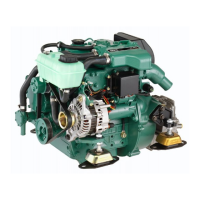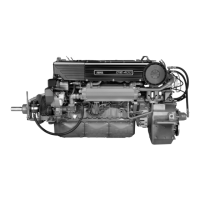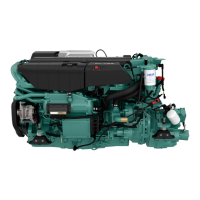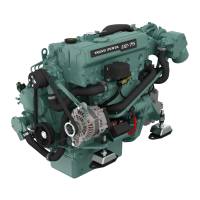Do you have a question about the Volvo Penta D6-435I and is the answer not in the manual?
Conditions under which the engine must not be started due to leak risks.
Function of the information panel for engine data, messages, and alarms.
Display of fault messages, acknowledgement, and information retrieval.
Description of various engine gauges sold as options by Volvo Penta.
Description of Volvo Penta controls and their functions.
Essential checks and procedures before starting the engine.
Steps for starting the engine and activating stations.
Instructions for starting and stopping engines from a specific station.
How alarms and messages are shown and handled.
Shifting between forward and reverse at idling speeds for comfort and transmission longevity.
Methods for stopping the engine using key or button.
Handling messages from the engine and EVC system, including cause and tasks.
Table listing symptoms and possible causes of engine malfunctions.
How malfunctions are presented via messages and system effects.
Automatic kick-up function, checks after grounding, and propeller/drive inspection.
Checking the tie rod for damage after running aground.
Warning and procedure for starting the engine using auxiliary batteries.
Manual engagement of gears if control lever shifting fails.
Manual shifting of the drive if control lever operation is prevented by a fault.
Routine to perform before restarting the engine after a crash-stop.
Identification of components for maintenance on D4 engine, starboard side.
Identification of components for maintenance on D4 engine, port side.
Identification of components for maintenance on D4 engine with drive, starboard.
Identification of components for maintenance on D4 engine with drive, port.
Identification of components for maintenance on D6 engine, starboard side.
Identification of components for maintenance on D6 engine, port side.
General inspection of engine and engine bay for leaks and wear.
Procedure for changing engine oil and filters.
Procedure for replacing oil and by-pass filters.
Importance of coolant mixture for engine protection and cooling.
Procedure for checking and topping up the coolant level.
Description of the raw water cooling system and its importance.
Checking and replacing the raw water pump impeller.
Description of the hydraulic reverse gear and its components.
Procedure for changing reverse gear oil and filter.
Protection against galvanic corrosion and paintwork repair.
Procedure for changing transmission oil, including propeller removal.
Advice on propeller replacement and safe handling during work.
Information about the hydraulic steering system.
Ensuring engine and drivetrain are not damaged during winter storage.
Conservation tasks to perform before taking the boat out of the water.
Conservation tasks to perform after the boat is out of the water.
Checking and topping up oil levels in engine and stern drive.
Starting the engine and checking for leaks and functioning controls.
Key engine specifications like displacement, bore, stroke, and weight.
Information on engine oil grades, viscosity, and change intervals.
Fuel specifications including standards and sulfur content.
Fresh water system volume and thermostat opening temperatures.
System voltage, alternator power, and battery capacity.
Oil capacity, volume difference, quality, and viscosity for different drive types.
Location and appearance of type plates for engine, transmission, and drive.
Conditions under which the engine must not be started due to leak risks.
Function of the information panel for engine data, messages, and alarms.
Display of fault messages, acknowledgement, and information retrieval.
Description of various engine gauges sold as options by Volvo Penta.
Description of Volvo Penta controls and their functions.
Essential checks and procedures before starting the engine.
Steps for starting the engine and activating stations.
Instructions for starting and stopping engines from a specific station.
How alarms and messages are shown and handled.
Shifting between forward and reverse at idling speeds for comfort and transmission longevity.
Methods for stopping the engine using key or button.
Handling messages from the engine and EVC system, including cause and tasks.
Table listing symptoms and possible causes of engine malfunctions.
How malfunctions are presented via messages and system effects.
Automatic kick-up function, checks after grounding, and propeller/drive inspection.
Checking the tie rod for damage after running aground.
Warning and procedure for starting the engine using auxiliary batteries.
Manual engagement of gears if control lever shifting fails.
Manual shifting of the drive if control lever operation is prevented by a fault.
Routine to perform before restarting the engine after a crash-stop.
Identification of components for maintenance on D4 engine, starboard side.
Identification of components for maintenance on D4 engine, port side.
Identification of components for maintenance on D4 engine with drive, starboard.
Identification of components for maintenance on D4 engine with drive, port.
Identification of components for maintenance on D6 engine, starboard side.
Identification of components for maintenance on D6 engine, port side.
General inspection of engine and engine bay for leaks and wear.
Procedure for changing engine oil and filters.
Procedure for replacing oil and by-pass filters.
Importance of coolant mixture for engine protection and cooling.
Procedure for checking and topping up the coolant level.
Description of the raw water cooling system and its importance.
Checking and replacing the raw water pump impeller.
Description of the hydraulic reverse gear and its components.
Procedure for changing reverse gear oil and filter.
Protection against galvanic corrosion and paintwork repair.
Procedure for changing transmission oil, including propeller removal.
Advice on propeller replacement and safe handling during work.
Information about the hydraulic steering system.
Ensuring engine and drivetrain are not damaged during winter storage.
Conservation tasks to perform before taking the boat out of the water.
Conservation tasks to perform after the boat is out of the water.
Checking and topping up oil levels in engine and stern drive.
Starting the engine and checking for leaks and functioning controls.
Key engine specifications like displacement, bore, stroke, and weight.
Information on engine oil grades, viscosity, and change intervals.
Fuel specifications including standards and sulfur content.
Fresh water system volume and thermostat opening temperatures.
System voltage, alternator power, and battery capacity.
Oil capacity, volume difference, quality, and viscosity for different drive types.
Location and appearance of type plates for engine, transmission, and drive.
| Power Output | 435 hp |
|---|---|
| Displacement | 5.5 L |
| Max Engine Speed | 3500 rpm |
| Fuel System | Common rail |
| Compression Ratio | 17.5:1 |
| Engine Type | Diesel |
| Cooling System | Freshwater cooling |
| Bore | 103 mm |
| Stroke | 110 mm |
| Emissions Compliance | EPA Tier 3 |











